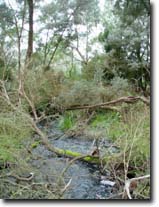Module 2: Wood to Water: Habitation creation within restored and replanted riparian land
Productive Grazing, Healthy Rivers - Home
| Background Most streams flowing through grazing properties within the project bioregions contain a small proportion of the woody debris (also known as snags) that would have been present in their natural state. Clearing or loss of riparian native vegetation along stream banks reduces the source of material that creates snags. In addition, farmers often remove woody debris and destroy snags in the belief that they impede water movement, contribute to bank erosion and “look untidy”. |  |
Aim This module will investigate a method of creating terrestrial and in-stream habitat (adding snags) to improve biodiversity values in restored riparian sites. It is expected that short-term changes and measurable biodiversity improvements will result, especially in locations with high quality riparian vegetation upstream to act as a source for aquatic species colonisation of the new habitat. | |
Our approach Discarded branches of locally indigenous tree species will be placed into streams to accelerate the process of habitat formation for macro-invertebrates, fish and terrestrial fauna species. Sites will be surveyed before and after the placement of branches to examine changes in the aquatic biodiversity. | |
| Contact Dr Sharon Aarons Ph: (03) 5624 2222 Email: Sharon.Aarons@dpi.vic.gov.au | |
Module 1: What lives along your stream? Quantifying on-farm riparian biodiversity
Productive Grazing, Healthy Rivers - Improving riparian and in-stream biodiversity - Project Report 2006 - Module 1 - Quantifying on-farm riparian biodiversity (PDF 289KB). To view the information PDF requires the use of a PDF reader. This can be installed for free from the Adobe website (external link).
Module 2: Wood to Water: habitat creation within restored and replanted riparian land
Productive Grazing, Healthy Rivers - Improving riparian and in-stream biodiversity - Project Report 2006 - Module 2 Wood to Water: Habitat creation within replanted riparian land (PDF 142KB). To view the information PDF requires the use of a PDF reader. This can be installed for free from the Adobe website (external link).
Module 3: Regeneration in remnant vegetation: overcoming the barriers
Productive Grazing, Healthy Rivers - Improving riparian and in-stream biodiversity - Project Report 2006 - Module 3 - Regeneration in remnant vegetation: Overcoming the barriers (PDF145KB). To view the information PDF requires the use of a PDF reader. This can be installed for free from the Adobe website (external link).
Module 4: Expert weed system: a support tool for on-farm management
Productive Grazing, Healthy Rivers - Improving riparian and in-stream biodiversity - Project Report 2006 - Module 4 - Riparian weed management system: Development of on-farm management tool (PDF 70KB). To view the information PDF requires the use of a PDF reader. This can be installed for free from the Adobe website (external link).
Module 5: Riparian condition and land-use practices: a survey of riparian health on dairy farms
Productive Grazing, Healthy Rivers - Improving riparian and in-stream biodiversity - Project Report 2006 - Module 5 - Riparian condition and land-use practices: A survey of riparian health & condition on dairy farms (PDF 127KB). To view the information PDF requires the use of a PDF reader. This can be installed for free from the Adobe website (external link).
Module 6: Riparian zone management: reducing water quality impacts from dairy cows
Productive Grazing, Healthy Rivers - Improving riparian and in-stream biodiversity - Project Report 2006 - Module 6 - Riparian zone management: Reducing water quality impacts on dairy cows (PDF 304KB). To view the information PDF requires the use of a PDF reader. This can be installed for free from the Adobe website (external link).


